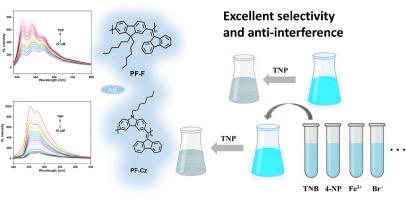Aggregation-induced emission active conjugated polymers containing fluorene and carbazole for detection of 2,4,6-trinitrophenol
IF 4.2
3区 工程技术
Q2 CHEMISTRY, APPLIED
引用次数: 0
Abstract
The detection of trace nitroaromatic explosives has become one of the hottest research areas in the field of environmental pollution monitoring. Designing aggregation-induced emission (AIE) active molecules, with flexible structural modifications and high fluorescence quantum yields, as fluorescence sensing materials offers a promising strategy for detecting nitroaromatic compounds. Here, two tetraarylethylene-based conjugated polymers named PF-F and PF-Cz were synthesized via Suzuki cross-coupling polymerization using dibromo-substituted 9-methylenefluorene and dihexylfluorene diboronic acid or heptylcarbazole diboronic ester, respectively. These polymers exhibit distinct AIE characteristics, with fluorescence quantum yields enhanced by 187 and 72 times in THF/H2O (1/9, V/V) compared to pure THF. Fluorescence sensing experiments based on PF-F and PF-Cz demonstrate high sensitivity toward 2,4,6-trinitrophenol (TNP). With PF-Cz in THF/H2O (2/8, V/V), a Stern-Volmer quenching constant of 1.56 × 105 M−1 was obtained, while the limit of detection (LOD) reached 0.09 μM. Moreover, both polymers exhibited high selectivity and anti-interference performance when exposed to various nitro-compounds and prevalent ions during the detection of TNP. Furthermore, the spike/recovery experiments for TNP detection based on PF-F and PF-Cz in actual aqueous samples yield recoveries ranging from 97.40 % to 107.40 %. Statistical t-tests indicate that the observed detection values are not significantly different from the actual concentrations added, demonstrating the reliability and sensitivity of PF-F and PF-Cz for TNP detection in real water samples.

含芴和咔唑的聚合诱导发射活性共轭聚合物检测2,4,6-三硝基苯酚
痕量硝基芳香炸药的检测已成为环境污染监测领域的研究热点之一。设计具有灵活结构修饰和高荧光量子产率的聚集诱导发射(AIE)活性分子作为荧光传感材料,为检测硝基芳香族化合物提供了一种很有前途的策略。本文以二溴取代的9-亚甲基芴和二己基芴二硼酸或庚基咔唑二硼酯为原料,采用铃木交联聚合法制备了两种四芳基乙烯基共轭聚合物PF-F和PF-Cz。这些聚合物具有明显的AIE特性,与纯THF相比,在THF/H2O (1/9, V/V)中荧光量子产率提高了187倍和72倍。基于PF-F和PF-Cz的荧光传感实验表明,对2,4,6-三硝基苯酚(TNP)具有较高的灵敏度。PF-Cz在THF/H2O (2/8, V/V)中的猝灭常数为1.56 × 105 M−1,检出限(LOD)为0.09 μM。此外,这两种聚合物在TNP检测过程中暴露于各种硝基化合物和流行离子时均表现出高选择性和抗干扰性能。此外,基于PF-F和PF-Cz在实际水样中检测TNP的峰值/回收率实验的回收率在97.40% ~ 107.40%之间。统计t检验表明,观察到的检出值与实际添加浓度无显著差异,证明了PF-F和PF-Cz在实际水样中检测TNP的可靠性和灵敏度。
本文章由计算机程序翻译,如有差异,请以英文原文为准。
求助全文
约1分钟内获得全文
求助全文
来源期刊

Dyes and Pigments
工程技术-材料科学:纺织
CiteScore
8.20
自引率
13.30%
发文量
933
审稿时长
33 days
期刊介绍:
Dyes and Pigments covers the scientific and technical aspects of the chemistry and physics of dyes, pigments and their intermediates. Emphasis is placed on the properties of the colouring matters themselves rather than on their applications or the system in which they may be applied.
Thus the journal accepts research and review papers on the synthesis of dyes, pigments and intermediates, their physical or chemical properties, e.g. spectroscopic, surface, solution or solid state characteristics, the physical aspects of their preparation, e.g. precipitation, nucleation and growth, crystal formation, liquid crystalline characteristics, their photochemical, ecological or biological properties and the relationship between colour and chemical constitution. However, papers are considered which deal with the more fundamental aspects of colourant application and of the interactions of colourants with substrates or media.
The journal will interest a wide variety of workers in a range of disciplines whose work involves dyes, pigments and their intermediates, and provides a platform for investigators with common interests but diverse fields of activity such as cosmetics, reprographics, dye and pigment synthesis, medical research, polymers, etc.
 求助内容:
求助内容: 应助结果提醒方式:
应助结果提醒方式:


